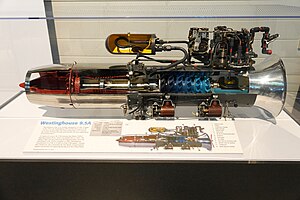Westinghouse J32
| J32 | |
|---|---|
 | |
| Cut-away Westinghouse 9.5A/J32 turbojet engine on display at the Steven F. Udvar-Hazy Center | |
| Type | Turbojet |
National origin | United States |
| Manufacturer | Westinghouse Aviation Gas Turbine Division |
| First run | 1944 |
Number built | 44 |
Developed from | Westinghouse J30 |
The Westinghouse J32 was a small turbojet engine developed by the Westinghouse Aviation Gas Turbine Division in the mid-1940s.
Contents
1 Design and development
2 Variants
3 Applications
4 Engines on display
5 Specifications (9.5A)
5.1 General characteristics
5.2 Components
5.3 Performance
6 Notes
7 References
8 External links
Design and development
Development of the 9.5A (military designation J32-WE-2) began in late 1942, and Westinghouse delivered the first engine to the U.S. Navy in mid-1944. The Navy selected the 9.5A to power the Gorgon II-B and III-B air-to-air missiles, but these applications did not materialize."
An improved version, the 9.5B, powered the TD2N-1 Gorgon high-speed target drone, which successfully flew in 1945. The engine's high cost and continuing development delays led to the cancellation of the TD2N-1 program in 1946. Westinghouse manufactured 24 of the 9.5A and 20 of the 9.5B engines. Despite their limited use, they constituted the first family of small turbojet engines successfully developed and produced in the United States.
Variants
- J32
- Military designation of the Westinghouse 9.5 turbojet engine
- Westinghouse 9.5A
- Company designation of the J32, denoting the diameter of the engine in inches
- Westinghouse 9.5B
- Improved version of the 9.5A
Applications
NAMU KDN-1 Gorgon high-speed target drone
Engines on display
A cutaway Westinghouse 9.5A/J32 turbojet engine is on display at the Steven F. Udvar-Hazy Center in Washington D.C.
Specifications (9.5A)
Data from [1]
General characteristics
Type: Axial flow turbojet
Length: 55.2 in (1,402.1 mm)
Diameter: 9.5 in (241.3 mm)
Dry weight: 9.5A 143 lb (64.9 kg), 9.5B 145 lb (65.8 kg)
Components
Compressor: 6-stage axial
Combustors: Annular stainless steel
Turbine: Single-stage axial
Fuel type: 100/130 gasoline
Oil system: pressure spray at 65 psi (448.2 kPa)
Performance
Maximum thrust: 9.5A 275 lbf (1.22 kN) at 36,000 rpm at sea level, 9.5B 260 lbf (1.16 kN) at 34,000 rpm at sea level
Overall pressure ratio: 3:1
Air mass flow: 5.25 lb (2.38 kg)/s at 28,000 rpm
Turbine inlet temperature: 1,500 °F (816 °C)
Specific fuel consumption: 1.7 lb/(lbf h) (173.3 kg/(kN h))
Thrust-to-weight ratio: 1.92 lbf/lb (0.0189 kN/kg)
Normal thrust, static: 9.5A 175 lbf (0.78 kN) at 29,800 rpm at sea level, 9.5B 260 lbf (1.16 kN) at 34,000 rpm at sea level
Military thrust, flight: 215 lbf (0.96 kN) at 36,000 rpm at altitude
Normal thrust, flight: 160 lbf (0.71 kN) at 29,800 rpm at altitude
Notes
^ Wilkinson, Paul H. (1946). Aircraft Engines of the world 1946. London: Sir Isaac Pitman & Sons. pp. 276–277..mw-parser-output cite.citationfont-style:inherit.mw-parser-output .citation qquotes:"""""""'""'".mw-parser-output .citation .cs1-lock-free abackground:url("//upload.wikimedia.org/wikipedia/commons/thumb/6/65/Lock-green.svg/9px-Lock-green.svg.png")no-repeat;background-position:right .1em center.mw-parser-output .citation .cs1-lock-limited a,.mw-parser-output .citation .cs1-lock-registration abackground:url("//upload.wikimedia.org/wikipedia/commons/thumb/d/d6/Lock-gray-alt-2.svg/9px-Lock-gray-alt-2.svg.png")no-repeat;background-position:right .1em center.mw-parser-output .citation .cs1-lock-subscription abackground:url("//upload.wikimedia.org/wikipedia/commons/thumb/a/aa/Lock-red-alt-2.svg/9px-Lock-red-alt-2.svg.png")no-repeat;background-position:right .1em center.mw-parser-output .cs1-subscription,.mw-parser-output .cs1-registrationcolor:#555.mw-parser-output .cs1-subscription span,.mw-parser-output .cs1-registration spanborder-bottom:1px dotted;cursor:help.mw-parser-output .cs1-ws-icon abackground:url("//upload.wikimedia.org/wikipedia/commons/thumb/4/4c/Wikisource-logo.svg/12px-Wikisource-logo.svg.png")no-repeat;background-position:right .1em center.mw-parser-output code.cs1-codecolor:inherit;background:inherit;border:inherit;padding:inherit.mw-parser-output .cs1-hidden-errordisplay:none;font-size:100%.mw-parser-output .cs1-visible-errorfont-size:100%.mw-parser-output .cs1-maintdisplay:none;color:#33aa33;margin-left:0.3em.mw-parser-output .cs1-subscription,.mw-parser-output .cs1-registration,.mw-parser-output .cs1-formatfont-size:95%.mw-parser-output .cs1-kern-left,.mw-parser-output .cs1-kern-wl-leftpadding-left:0.2em.mw-parser-output .cs1-kern-right,.mw-parser-output .cs1-kern-wl-rightpadding-right:0.2em
References
.mw-parser-output .refbeginfont-size:90%;margin-bottom:0.5em.mw-parser-output .refbegin-hanging-indents>ullist-style-type:none;margin-left:0.mw-parser-output .refbegin-hanging-indents>ul>li,.mw-parser-output .refbegin-hanging-indents>dl>ddmargin-left:0;padding-left:3.2em;text-indent:-3.2em;list-style:none.mw-parser-output .refbegin-100font-size:100%
Wilkinson, Paul H. (1946). Aircraft Engines of the world 1946. London: Sir Isaac Pitman & Sons. pp. 276–277.- This article contains material that originally came from the placard at the Steven F. Udvar-Hazy Center.
Leyes, Richard A.; Fleming, William A. (1999). The History of North American Small Gas Turbine Aircraft Engines. Reston, Virginia: Smithsonian Institution and the American Institute of Aeronautics and Astronautics. ISBN 1-56347-332-1.
Kay, Anthony L. (2007). Turbojet History and Development 1930-1960 Volume 2:USSR, USA, Japan, France, Canada, Sweden, Switzerland, Italy and Hungary (1st ed.). Ramsbury: The Crowood Press. ISBN 978-1861269393.
External links
| Wikimedia Commons has media related to Westinghouse J32. |
"Westinghouse J32-WE-2 (9.5A) Turbojet Engine, Cutaway". Smithsonian National Air and Space Museum. Retrieved 1 January 2011.
